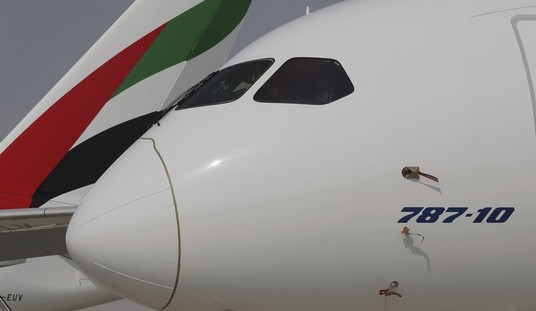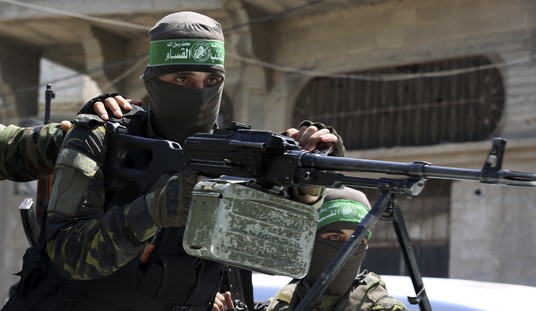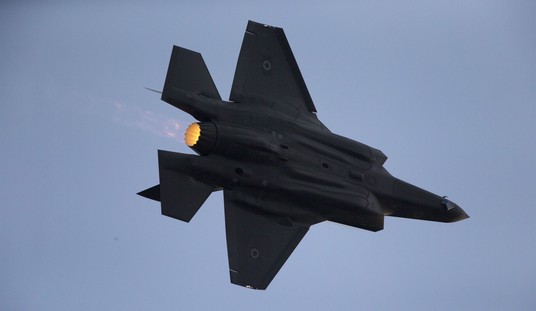
Depp at Lone Ranger premiere. To be fair, being able to feign this level of enthusiasm when offering up a cinematic turkey is itself pretty darn good acting.
(Photo by Featureflash / Shutterstock.com)
The Johny Depp Lone Ranger movie, at least based on early box office results, is shaping up to be quite the bomb. (Matt Drudge dubbed it “Kemobombe” earlier this week.) First, there’s the running time; like all too many Hollywood action movies today, the Lone Ranger is an inversion of the Catskills joke Woody Allen tells at the start of Annie Hall: The food here is terrible — and such large portions, too. The Atlantic describes “A Punishingly Overlong Lone Ranger,” clocking in at 149 painful minutes:
As cinematic sins go, excessive length is hardly an original one. The delusion that bigger will always be better—that each additional plot twist will somehow signify ingenuity rather than desperation—is by now a fundamental operating principle in Hollywood. Blockbuster directors demand movies large enough to house their egos; the studios are in a state of near-constant panic (and theater owners even more so); genuine storytelling is migrating to television; a lengthy series of explosions translates seamlessly in Beijing or Rio de Janeiro; and on and on.
But to quote Jerry Seinfeld, something’s gotta give. I’m sure if I set my mind to it, I could name a recent big-budget film that would have benefited from greater length. But a list of the big-budget films that would have been substantially improved by a zealous trim is… well, awfully similar to a list of big-budget films, period. I can’t say whether I might enjoy a Transformers movie that was under two hours long—but one reason that I can’t say is because the ones that Michael Bay has offered up to us have clocked in at 144, 149, and 154 minutes respectively. And it’s not just the summer blockbusters: Les Miserables was a polished, well-crafted film that labored under the misconception that viewers wanted to pass the 19th century in real time. And don’t get me started on Peter Jackson’s first installment of The Hobbit or, like the movie itself, I might never stop. The only 140-minute-plus movie of the past two years that I can recall fully earning its running time was Zero Dark Thirty.
The liberal sci-fi-themed io9 Website’s review of the Lone Ranger doesn’t make the film sound like an enjoyable nine hours in the movie theater:
What makes the Lone Ranger finally embrace the need for his mask, and hence the whole “secret identity” thing? In a nutshell, he realizes his fellow white men are corrupt, and complicit in the mass murder of Tonto’s fellow Native Americans. If he takes the mask off, then he too will wind up becoming complicit. Yes, that’s right — in this film, the Lone Ranger’s mask is made of White Guilt.
And in fact, the only function the Native Americans in this film have, other than Tonto, is to die horribly so that the Lone Ranger will have a catalyst to make him Man Up.
But it’s more than that. We tend to think of superhero movies as power fantasies, in which the use of America’s status as a superpower is reflected by the hero struggling to use his or her power responsibly. But Lone Ranger seems to be making the case that the real seductive fantasy of these stories is absolution from blame — the Lone Ranger gets the Native American seal of approval from Tonto, as long as he’s wearing the mask. He gets surcease from America’s original sin.
That’s the secret of superheroes, according to this film: Peter Parker is a Tool of the Man, but Spider-Man is a free agent. Bruce Wayne is a capitalist running dog, but Batman fights for the little guy.
And that’s why you deserve to suffer. Because a lot of innocent people had to die to make your costume fantasy possible, you bastards.
Yeah, that’s the message I want to take away from a summer escapist comic book movie.
More — sadly not Clayton Moore, alas — right after the page break.
For similar reasons, Aaron Clarey, the Blogosphere’s “Captain Capitalism,” and the author of Enjoy the Decline explains why “I Will Not See the Lone Ranger:”
From our agent in the field:
“In one of the busier scenes in Gore Verbinski’s very busy The Lone Ranger, dozens if not hundreds of Comanche tribesmen are brutally gunned down by a machine-gun-armed U.S. Cavalry. This sad and ugly violence — employed to represent the larger cultural annihilation being waged throughout the American West in the bloody era of Manifest Destiny — is intercut with shots of Johnny Depp, at the moment dressed up like a Chinese rail worker but face still covered in warpaint, furiously pumping a railway handcar with a blindfolded Armie Hammer as his passenger. Tonto and the Lone Ranger’s wacky, madcap getaway complete, we are then allowed a somber moment to pause and reflect on the terrible bloodshed to which we were just subjected.”
I said it before, and I’ll say it again, I’m sick and tired of being lectured by leftists and race whores blaming me and trying to shame me for things I didn’t do. And I’m not going to pay them or give them my money.
Similarly, Christian Toto adds that despite it being produced by the ordinarily audience-friendly Jerry Bruckheimer, “‘The Lone Ranger’ Follows P.C. Narrative, Smites Greedy Capitalist:”
We first meet an aged Tonto (Johnny Depp) as he participates in a “Wild West”-style carnival show under the title “Noble Savage” circa 1933.
It’s a way to tell audiences, “hey, we understand the context of a new Lone Ranger film, and this project won’t be offensive to Native Americans.”
That isn’t enough for the film, produced by the typically pro-American film veteran Jerry Bruckheimer. The movie revisits the theme of the evil white man, particularly during one exchange featuring Depp’s Tonto character.
“What does the white man kill for?” he asks, one of those rhetorical questions meant to linger long after the scene wraps.
And is it a spoiler to say that one of the film’s heavies is a capitalist?
Sadly, not today, despite the need for Hollywood to make money to stay afloat. At Deadline Hollywood, Nikki Finke runs down the film’s numbers:
Disney’s expensive The Lone Ranger (3,904 theaters) received a ‘B+’ CinemaScore from audiences who obviously disagreed with the lousy reviews given the movie by professional critics. So word of mouth may help this Western overcome its disastrous opening that underperformed for only $9.6M Wednesday. Rival studios say that means the Jerry Bruckheimer-branded tentpole may not even pass $45M for its first 5 days barring a miracle. This is way below even Disney’s lowball domestic projection of $65M which the studio today revised down to $43M-$43M. Exit polling showed the movie skewed 56% male and 66% age 25 and older while complaints pour in about its content. “A Disney film that may be seriously inappropriate for families is tough,” a rival studio mogul told me this morning. Now the two-quadrant actioner likely won’t cover its high $215M-$250M cost despite this holiday’s 4x multiple. One head-scratcher is where all that money went. Apparently to above the line costs like stars Johnny Depp and Armie Hammer and director Gore Verbinski and producer Bruckheimer and the 3 credited screenwriters Justin Haythe, Ted Elliott & Terry Rossio.
So will Disney’s investment in the Lone Ranger be saved by its overseas box office? A running leitmotif in Lynda Obst’s new book Sleepless in Hollywood (discussed previously here), is that movies with “dust” gather dust — and not audiences — outside of America:
It was a rule of thumb that movies with what movie people call “dust”— i.e., westerns, or movies in the dusty hinterlands— never worked abroad. Why this is, we don’t really know. In the old studio days we exported our classic westerns. But in the modern movie business, the mere presence of either “dust” or cowboy hats— or horses, for that matter— is thought to make a picture dead on arrival, even if it isn’t a western.
Which dovetails perfectly with Finke’s thoughts later in her post on the Lone Ranger at Deadline Hollywood:
Depp’s worldwide popularity may, repeat may, help overseas where oaters usually don’t excel. Lone Ranger opens day and date in 30% of the foreign landscape but only 4 big markets: Italy and Russia (releasing July 2) and Australia and Korea (July 4). Disney first announced the project five years ago (when Dick Cook was chairman of Walt Disney Studios) and it was always a risky bet since young moviegoers have largely stayed away from Westerns and have little familiarity with the masked man or his sidekick.
So Disney gambled up to $250 million on a film whose title character is virtually unknown to 21st century audiences, in a genre that Black Armband leftists despise and as a result, conservatives distrust Hollywood’s inevitable revisionism, and is frequently a loser overseas. Perhaps it’s yet another reminder, as veteran screenwriter William Goldman likes to say about his industry, nobody knows anything.
(Headline explanation: For those who don’t recall, Spilsbury was the titular star of the equally doomed 1980 big-screen remake of the Lone Ranger, which would be “remembered” as his only big-screen role.)
Update: “From what I’ve read, it’s like Howard Zinn wrote the screenplay.” Don’t miss “Alone Ranger,” blogger Christopher Taylor’s deconstruction of this cinematic train wreck.









Join the conversation as a VIP Member